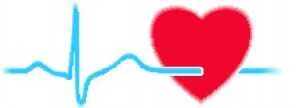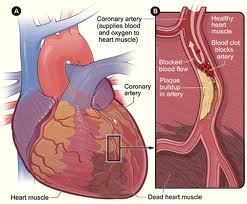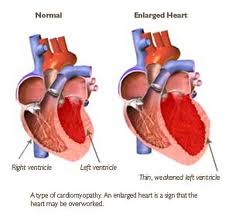Cardiac diseases are also known as heart diseases. Cardiac diseases are a very broad term for a number of conditions that affect the heart.
The most leading cause of cardiac disease is a narrowing of the lumen of arteries which supply blood to the heart, commonly called coronary artery disease (CAD).

There are various other heart conditions that come under the umbrella of cardiac diseases.
Types of Cardiac Disease
- Cardiovascular diseases
A number of conditions that affect the heart itself or any of the arteries or veins leading to and from the heart are called cardiovascular diseases. Most common conditions that cause cardiovascular diseases are:
- High blood pressure
- Diabetes
- Increased fats (lipids) in blood
- Hyperhomocysteinemia
The most common type of cardiovascular disease is atherosclerosis.
Coronary heart disease: A disease of the heart itself where the arteries supplying the heart muscles are clogged by atheromatous plaques.
An atheroma is a collection or a swelling on the vessel wall composed of fats, cell debris, calcium, connective fibrous tissues etc.
Symptoms
- Angina – chest pain due to insufficient blood supply to the heart
- ‘Ischemic heart disease’, is another term used to denote a condition where blood supply to the heart is reduced.
Congenital heart disease
Structural problems of the heart present right from birth are known as congenital heart disease. Genetic defects are the cause for this condition.
Here, heart cannot function properly because it is incompletely or improperly developed. There is an abnormal flow of blood through the heart. There occur abnormal heartbeats (arrhythmias), structural abnormalities and cardiomyopathies (abnormalities of the heart muscles). Abnormal connections between two arteries occurring outside the heart, valvular defects, or presence of holes within the muscular walls of the heart are some of the conditions frequently found.
Common conditions are:
- Atrial septal defects (ASD): A hole in the septa (membrane) dividing the atria (the upper chambers of the heart) allows oxygen-rich blood from the left atrium to flow into the right atrium instead of flowing to the left ventricle as it should. Many children with this defect show few symptoms, if any.
Most ASDs are small and need no treatment. Occasionally, medium sized ASDs require surgical correction with a catheter procedure.
- Ventricular septal defects (VSD): A hole in the membrane dividing the ventricles (lower chambers of the heart) oxygen rich blood to flow from the left ventricle into the right ventricle instead of flowing into the aorta and out to the body as it should. VSDs can be large or small.
- Large VSDs overload the left side of the heart and increase the pressures within the right side of the heart and within the lungs. There is more than usual volume of blood flowing into the lungs and within the right atrium. As the load on the heart increases, the patient can develop heart failure (also called congestive heart failure). Increased back-pressure on the lung can damage delicate arteries in the lungs. Hence, large VSDs need to be surgically repaired (open heart surgery) as soon as possible.
Valvular heart disease:
Valves are flap-like structure present at the openings of the atria into the ventricles, and at the openings into the large blood vessels arising from the heart. They prevent the back-flow of the blood as it passes (or is pumped) through the heart chambers. Any structural abnormalities of these valves bring about multifold changes in the dynamics of blood flow.
Common terms for valvular defects seen are:
- Stenosis: or narrowing of the lumen because the valves do not open properly. This means that the heart has to pump with added force to make the blood pass through the lumen.
- Atresia: this defect means that the valves do not develop correctly. They are ill-formed and mostly the lumen appears completely closed. So there is no opening from which the blood can pass through.
- Regurgitation: here the valves do not close properly. Hence, there is regurgitation or back-flow of the blood pumped, into the cambers.
The most common valvular defect encountered is: Pulmonary valve stenosis.
Through this valve, the blood flows from the right ventricle to the lungs where it picks up oxygen. When the valve is stenosed, the severity ranges from mild to severe. Mild forms require no treatment. Just occasionally, an abnormal heart sound (murmur) can be heard. Correction of the condition when necessary, it done by a catheter procedure.
Complex congenital heart defect:
The commonest complex congenital heart defect seen worldwide is known as ‘the Fallot’s tetralogy’.
This defect has a combination of the following:
- A large VSD
- Right ventricular hypertrophy – the muscles of the right ventricle enlarge due to the excess stress of pumping more than usual blood volumes.
- Overriding of the Aorta – the aorta is a large vessel carrying blood from the left ventricle to various body parts. Normally, its origin is in the left ventricle only. In the Fallot’s tetralogy, the aorta is placed above the left as well as the right ventricle as opposed to normal. Thus, impure blood from the right ventricle gets mixed with the pure (oxygenated) blood from the left ventricle.
- Pulmonary valve stenosis – this occasionally causes the presence of a murmur.
Cardiomyopathy:
Cardiomyopathy means any disease of the heart muscles themselves. The heart muscle is referred to as the ‘myocardium’. Any condition that causes impaired functioning of this muscle is considered as a cardiomyopathy.
The heart muscles become inflamed and don’t work as they should.
Common structural changes seen in the heart are:
- Dilatation of heart muscles
- Restricted contractility of the heart muscles
- Increased (hypertrophy) size of the heart muscles.
Previous heart attacks, viral and bacterial infections and many other conditions cause cardiomyopathies.





